Vadim Putrolaynen
Entropy-statistical approach to phase-locking detection of pulse oscillations: application for the analysis of biosignal synchronization
Jun 12, 2024Abstract:In this study a new method for analyzing synchronization in oscillator systems is proposed using the example of modeling the dynamics of a circuit of two resistively coupled pulse oscillators. The dynamic characteristic of synchronization is fuzzy entropy (FuzzyEn) calculated a time series composed of the ratios of the number of pulse periods (subharmonic ratio, SHR) during phase-locking intervals. Low entropy values indicate strong synchronization, whereas high entropy values suggest weak synchronization between the two oscillators. This method effectively visualizes synchronized modes of the circuit using entropy maps of synchronization states. Additionally, a classification of synchronization states is proposed based on the dependencies of FuzzyEn on the length of embedding vectors of SHR time series. An extension of this method for analyzing non-relaxation (non-spike) type signals is illustrated using the example of phase-phase coupling rhythms of local field potential of rat hippocampus. The entropy-statistical approach using rational fractions and pulse signal forms makes this method promising for analyzing biosignal synchronization and implementing the algorithm in mobile digital platforms.
A Bio-Inspired Chaos Sensor Based on the Perceptron Neural Network: Concept and Application for Computational Neuro-science
Jun 03, 2023Abstract:The study presents a bio-inspired chaos sensor based on the perceptron neural network. After training, the sensor on perceptron, having 50 neurons in the hidden layer and 1 neuron at the output, approximates the fuzzy entropy of short time series with high accuracy with a determination coefficient R2 ~ 0.9. The Hindmarsh-Rose spike model was used to generate time series of spike intervals, and datasets for training and testing the perceptron. The selection of the hyperparameters of the perceptron model and the estimation of the sensor accuracy were performed using the K-block cross-validation method. Even for a hidden layer with 1 neuron, the model approximates the fuzzy entropy with good results and the metric R2 ~ 0.5-0.8. In a simplified model with 1 neuron and equal weights in the first layer, the principle of approximation is based on the linear transformation of the average value of the time series into the entropy value. The bio-inspired chaos sensor model based on an ensemble of neurons is able to dynamically track the chaotic behavior of a spiked biosystem and transmit this information to other parts of the bio-system for further processing. The study will be useful for specialists in the field of computational neuroscience.
Switching dynamics of single and coupled VO2-based oscillators as elements of neural networks
Jan 07, 2020
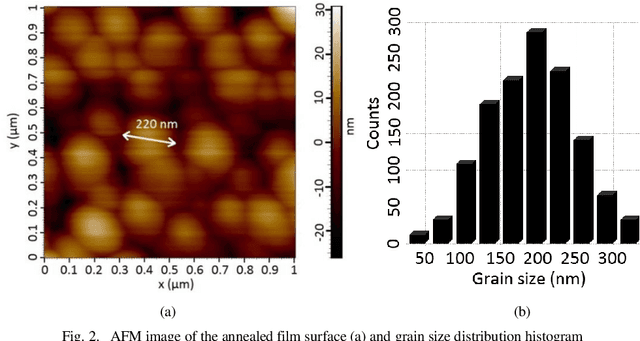


Abstract:In the present paper, we report on the switching dynamics of both single and coupled VO2-based oscillators, with resistive and capacitive coupling, and explore the capability of their application in oscillatory neural networks. Based on these results, we further select an adequate SPICE model to describe the modes of operation of coupled oscillator circuits. Physical mechanisms influencing the time of forward and reverse electrical switching, that determine the applicability limits of the proposed model, are identified. For the resistive coupling, it is shown that synchronization takes place at a certain value of the coupling resistance, though it is unstable and a synchronization failure occurs periodically. For the capacitive coupling, two synchronization modes, with weak and strong coupling, are found. The transition between these modes is accompanied by chaotic oscillations. A decrease in the width of the spectrum harmonics in the weak-coupling mode, and its increase in the strong-coupling one, is detected. The dependences of frequencies and phase differences of the coupled oscillatory circuits on the coupling capacitance are found. Examples of operation of coupled VO2 oscillators as a central pattern generator are demonstrated.
* 33 pages, 23 figures
Thermal coupling and effect of subharmonic synchronization in a system of two VO2 based oscillators
Jan 06, 2020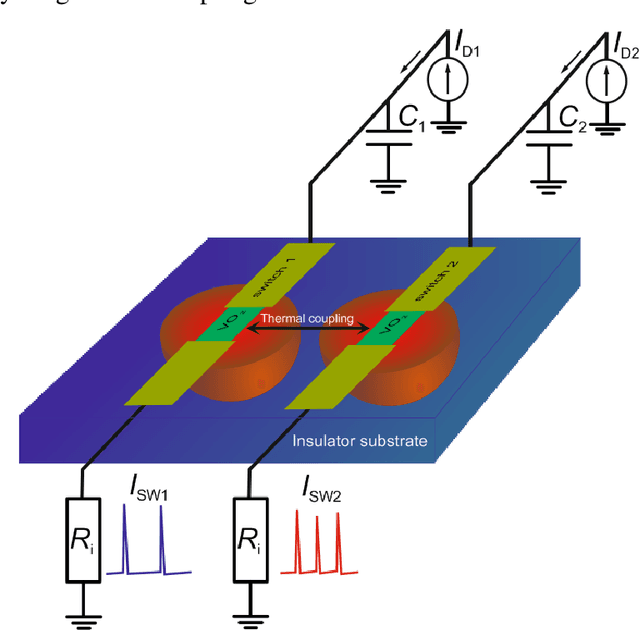
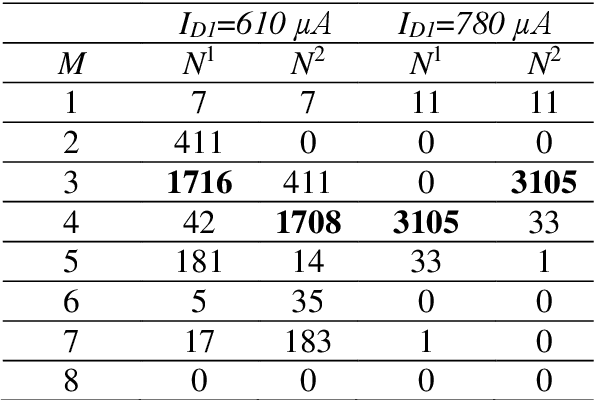
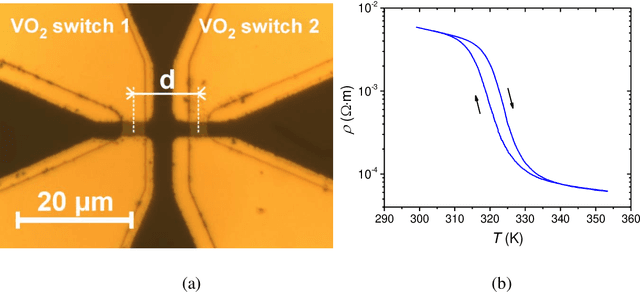
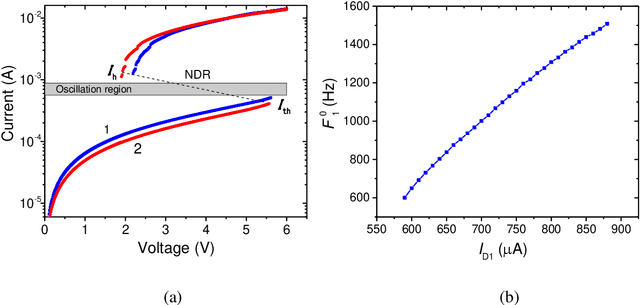
Abstract:We explore a prototype of an oscillatory neural network (ONN) based on vanadium dioxide switching devices. The model system under study represents two oscillators based on thermally coupled VO2 switches. Numerical simulation shows that the effective action radius RTC of coupling depends both on the total energy released during switching and on the average power. It is experimentally and numerically proved that the temperature change dT commences almost synchronously with the released power peak and T-coupling reveals itself up to a frequency of about 10 kHz. For the studied switching structure configuration, the RTC value varies over a wide range from 4 to 45 mkm, depending on the external circuit capacitance C and resistance Ri, but the variation of Ri is more promising from the practical viewpoint. In the case of a "weak" coupling, synchronization is accompanied by attraction effect and decrease of the main spectra harmonics width. In the case of a "strong" coupling, the number of effects increases, synchronization can occur on subharmonics resulting in multilevel stable synchronization of two oscillators. An advanced algorithm for synchronization efficiency and subharmonic ratio calculation is proposed. It is shown that of the two oscillators the leading one is that with a higher main frequency, and, in addition, the frequency stabilization effect is observed. Also, in the case of a strong thermal coupling, the limit of the supply current parameters, for which the oscillations exist, expands by ~ 10 %. The obtained results have a universal character and open up a new kind of coupling in ONNs, namely, T-coupling, which allows for easy transition from 2D to 3D integration. The effect of subharmonic synchronization hold promise for application in classification and pattern recognition.
* 24 pages, 10 figures
Effects of Higher Order and Long-Range Synchronizations for Classification and Computing in Oscillator-Based Spiking Neural Networks
Apr 10, 2018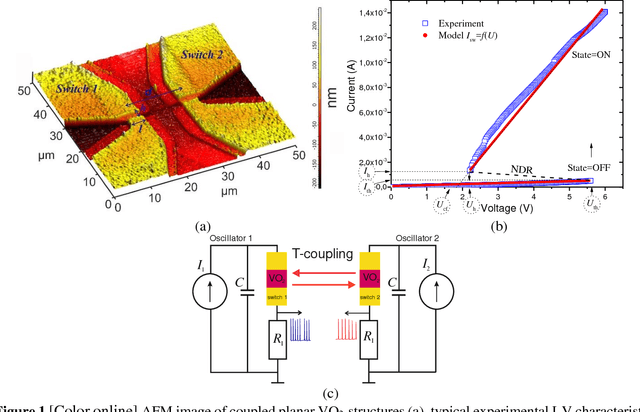
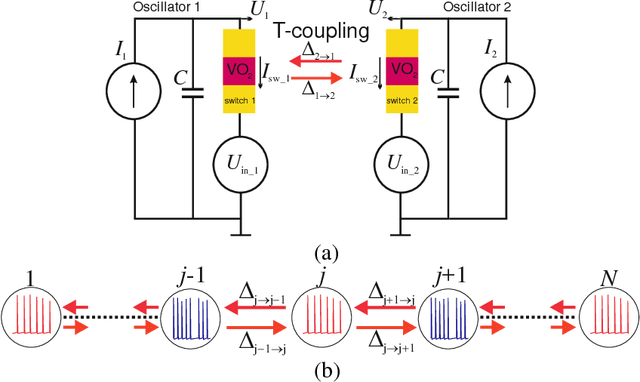
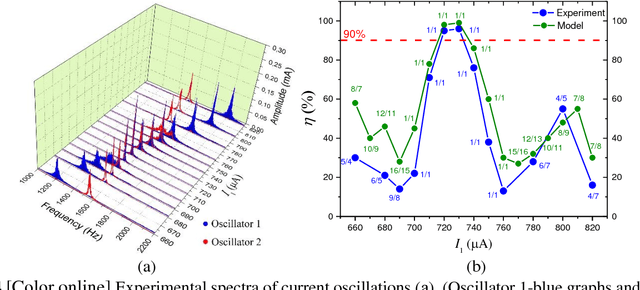
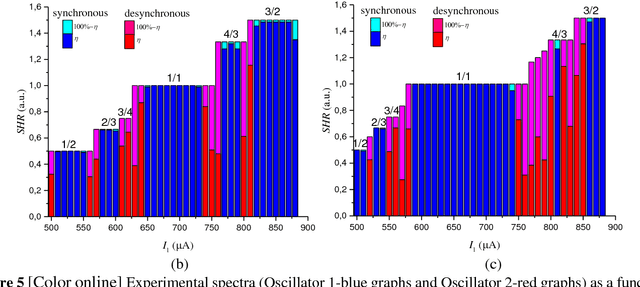
Abstract:Development of artificial oscillator-based spiking neural networks (SNN), which are able to solve effectively various cybernetics problems including image recognition and adaptive control, is a key line of research. We have thoroughly explored the scheme of two thermally coupled $VO_2$ oscillators and found its effect of high order synchronization (HOS), which may be used to increase SNN classification capacity $N_s$. Phase-locking estimation method has been developed to determine values of subharmonic ratio SHR and synchronization effectiveness {\eta}. The experimental scheme has $N_s=12$ and SHR distributions are shaped as Arnold's tongues. In a model $N_s$ may reach maximum of $N_s>150$ at certain levels of coupling strength and noise. We demonstrate the long-range synchronization effect in a one-dimensional chain of oscillators and the phenomenon of synchronization transfer even at low values of {\eta} for intermediate links. The paper demonstrates realization of analogue operation of "multiplication", binary logic, and possibility of development of the interface between SNN and computer. The described effects increasing classification capacity of oscillator schemes and calculation principles based on the universal physical effect - HOS may be applied for any spiking type oscillators with any coupling type therefore enhancing practical value of the presented results to expand SNN capabilities.
 Add to Chrome
Add to Chrome Add to Firefox
Add to Firefox Add to Edge
Add to Edge